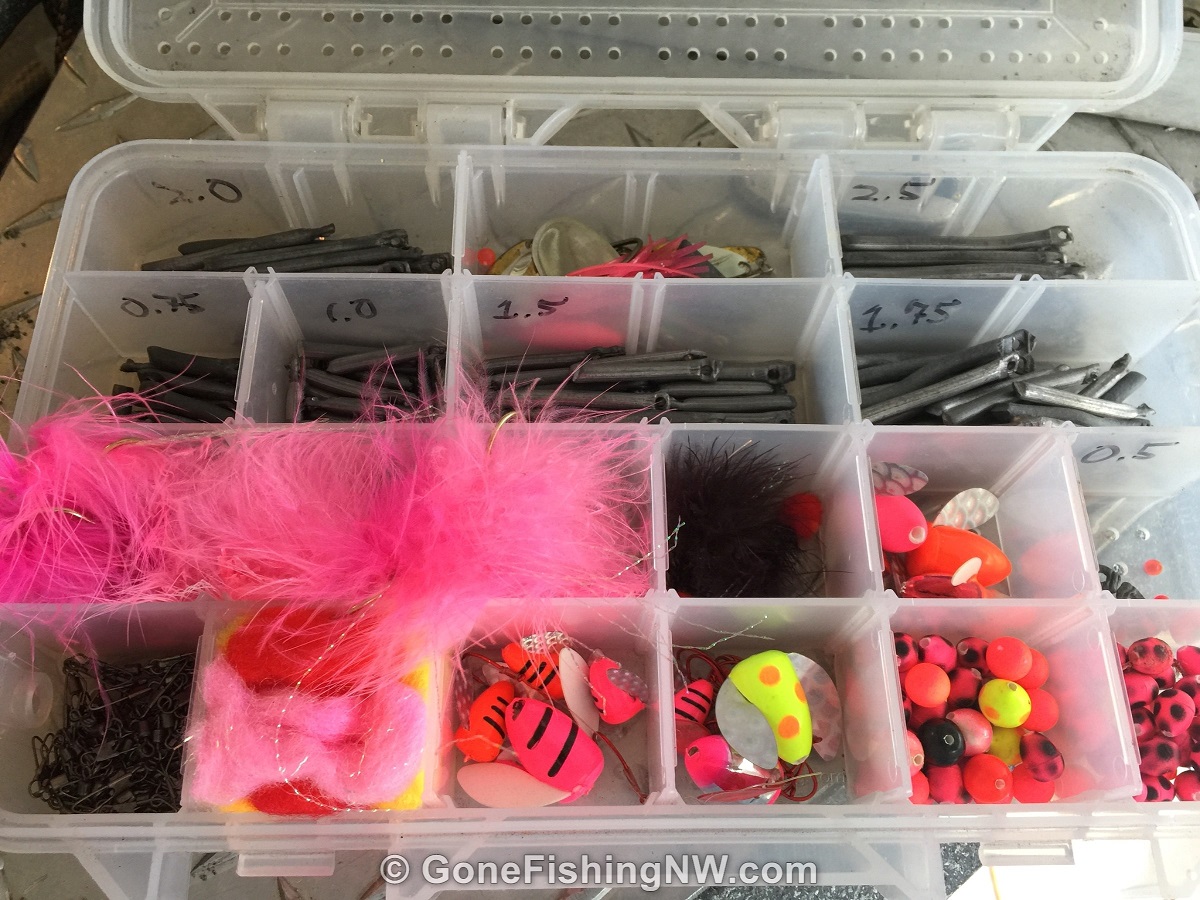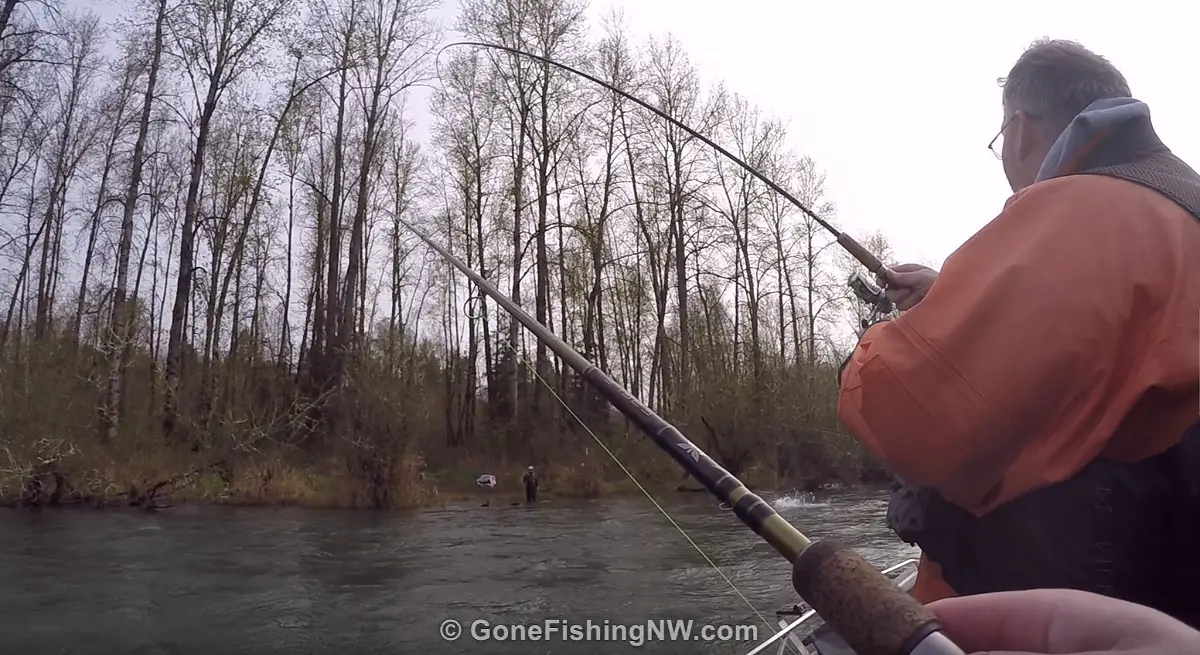Search
Latest Articles
Steelhead Side Drifiting 101
by Nathan Nesbit of GoneFishingNW.com, March 25, 2017
This boat based fishing technique is quite popular with fishing guides and recreational fishermen because it flat out puts fish in the boat. It doesn’t require much in special gear or lures – other than a boat, of course. The execution is simple – an experienced hand on the helm and a decently placed cast puts one well on the path to hooking up with a fish.
Roughly speaking side drifting consists of a few anglers in a boat. The boat is positioned at the head of an area that one wants to fish.
Gearing Up
While the fish don’t care about the exact gear you use to fish with, you will find that using the right gear will be easier, more enjoyable and ultimately help you catch more fish.
Rod and Reel
One of the things I like about side drifting is it is best done with lighter gear. To achieve the correct drift, minimal weight is used. In order to cast that weight effectively one needs a long light-action spinning rod. It should be moderate, or even slow action – which allows the fish to hold onto the lure longer before feeling any pressure.
Whatever the rod and reel, you should spool it up with 10-pound high visibility mono line.
Terminal Tackle
Next we consider the terminal tackle. Like a lot of fishing lures, the variations are almost endless. Yarnies and roe rigs are the most popular rigs, and account for most steelhead caught side drifting.
Yarnies are also called yarn ball or glo balls. They are very popular with guides as they are cheap and easy to build, can hold a variety of scents, can be in a range of colors, and of course are effective.
Complete steps and pictures on how to tie up yarnies is available in the full-length article on GoneFishingNW.com.
Roe rigs are simple. Just two size 4 hooks tied together, with a drift bobber in between. When you are on the water and ready to fish, cut a dime sized piece of roe. Attach it to the top hook using both the hook and the egg loop knot.
Weights
Regardless of which rig you use, you will need a bit of weight to cast it and to keep it close to bottom where the fish are. There are many choices of drift weights, but you’ll find most guides use pencil lead weight. It is cheap and easy to assemble in a variety of lengths.
Pencil lead weight comes in a coil. There are a few different diameters. I typically use 3/16 diameter for most of my fishing.
Instructions on how to prepare pencil lead weight are also available in the full-length article.
The amount of weight to use will vary based on river flow and depth. So, you will need to come prepared with a variety of lengths. Personally, I have a little box labeled with different lengths. Then on the water I can grab the desired length and attach it to my line.

When fishing, you want just enough weight to feel the gear tap bottom about every 3 to 5 seconds.
Rigging It All Up
Finally, we have all the various pieces and we can rig it all together.
1. Start by taking your mainline and tying on a size 7 snap swivel.
2. On the other end of the swivel (not the snap) tie on the end of your leader
3. Select the desired weight, and thread it onto the snap
4. Add scent/bait to the hook/yarn
You are now ready to fish.
Controlling The Boat
Arguably the most important part of side drifting is in the boat control. Sloppy boat control will result in no one being able to effectively fish.
It is harder than you may think, as structure will cause water to push to the side occasionally, as well as – of course - bends in the river and such.
Until you get experience controlling the boat during the drift, it is best to focus on boat control while your buddies are fishing. Once you feel like you have boat control down, then add in fishing while working the tiller.
In simple terms, you keep the boat pointed up stream, with the kicker motor running. The kicker is normally in forward gear, but with minimal throttle. You want to slow down the boat enough so it is moving just pulls the gear a bit.
As helmsman, you can do this by keeping an eye downstream and see what is coming. If there is structure which will cause the boat to push to one side, then right before you get there take steps to angle the boat so it will with the side current it will continue to drift straight downstream. This gets easier as you learn a river and do the same drift repeatedly.
At the end of the drift you may choose to run back up river and do it again, or drift a different section of the river.
Doing the Drift
When the helmsman gives the signal, line up along the side of the boat all facing towards the shoreline you will be fishing. Taking turns cast towards the shore, roughly 45-degree angle upstream. Usually you want to get it very close to the shoreline, but occasionally may aim at a current seam, near structure or other places where fish usually hang out.
Once the gear hits the water, close the bail on the reel and quickly take up any slack in the line. Slack can cause the weight to settle down and get snagged.
If your line gets out of position – either too far upstream or downstream, then reel back in and recast.
Detecting the Bite
For many people, it is hard to tell the difference between a bite and a snag, I suggest treating everything as a fish until you get enough experience to tell the difference.
The bite is often seen more than felt. When a fish bites (or the gear snags up), the lure stops moving – but the boat continues to drift downstream. This will cause the end of your rod to start bending and load up. Therefore, it is important to hold the rod up at a 10 o’clock position and keep an eye on the end of the rod.

Regardless if you think it is a fish or a snag, you want to then lift the rod quickly and set the hook. If you feel something tugging back, then it is a fish. If the gear comes free, or stays in a fixed position then it is a snag.
Dealing With Snags
With this method of fishing you will snag up. It is a fact of life, which is why you show up for a day of fishing with lots of leaders pre-tied.
When your gear snags up underwater, the thing to do is to point the rod directly at the snag. This will prevent the rod from bending and possibly breaking. Then grab the spool with one hand to keep it from spinning. As the boat moves downstream the line will get tighter and eventually something will snap.
Fighting the Fish
If you have been lucky and hooked a fish, then you need to fight it in. This is a cooperative effort for the whole boat.
Everyone else should reel in as fast as they can, so the fish will not get tangled in their lines. Put the rod someplace out of the way, and make sure nothing in dangling in the water. The helmsman usually takes the motor out of gear, to avoid the prop from catching the line.
You may need to follow the fish around the boat as it fights. If the fish goes under the boat, put the end of the rod under the water, to prevent the line from rubbing on the boat.
Conclusion
Side drifting is a fun and very productive way to catch steelhead. It takes some preparation and practice, but once mastered allows you to keep your gear in the “zone” longer than most way of fishing – and that translates to more fish to the boat.


